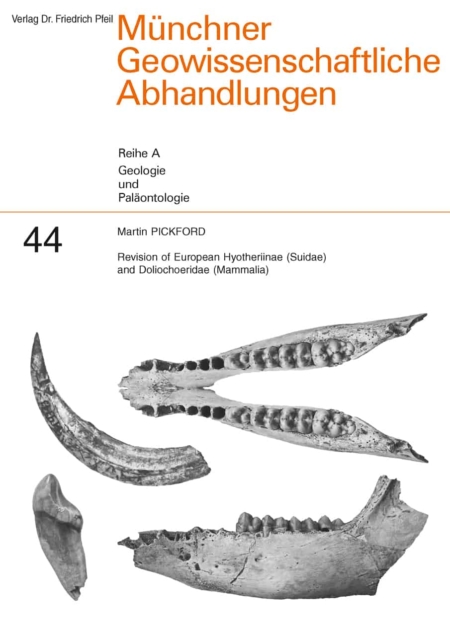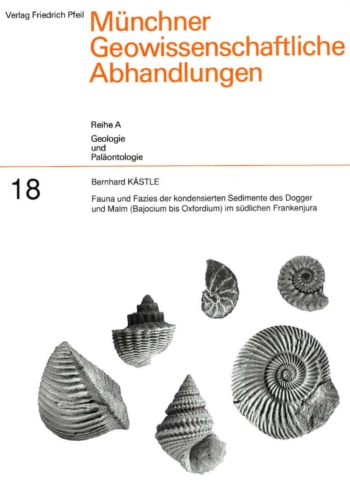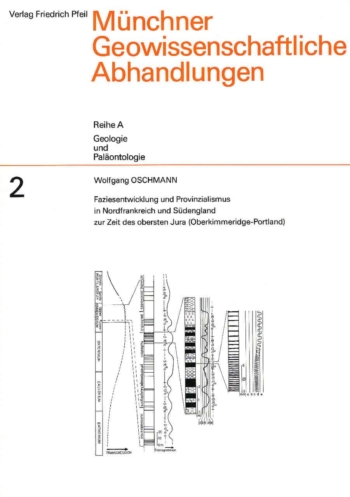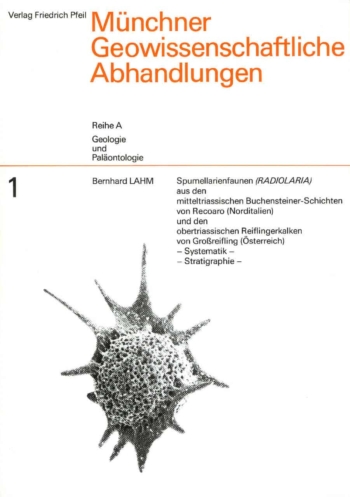This monograph treats bunodont suoids mainly from Europe, some from Africa and in passing mentions some Chinese material. It is an in-depth revision of the Hyotheriinae (Suidae) and Doliochoeridae (previously called the Palaeochoeridae) from Oligocene and Early to basal Middle Miocene levels, for which a summary of European Oligo-Miocene biostratigraphy is provided.
Revision of European Hyotheriinae (Suidae) and Doliochoeridae (Mammalia)
2016. [Englisch] – 270 Seiten, 199 Abbildungen, 101 Tabellen, 1 Anhang.
29,7 x 21,0 cm, Paperback.
80,00 €
zzgl. Versandkosten / Versandkostenfrei in D
Introduction 9
Weisenau and Mösskirch Suidae
and the problematic species
Hyotherium medium Von Meyer, 1841a 10
Material and Methods 11
Organisation of Systematic Descriptions 13
Designation of tooth position 13
Measurements 13
Geological Time Scale and Biostratigraphy 13
Oligo-Miocene Biostratigraphy in Europe 13
Occurrences of Hyotherium in Europe
(whether verii, dubii or spurri) 15
Biostratigraphy of Mösskirch 17
Historically early samples of Hyotherium 17
Archives 19
Literature 20
Context of suid studies over time 21
Geochronology 21
Socio-politics 21
Suprageneric classification
of suid-like mammals 22
Historical review the genus Hyotherium
with the focus on Mösskirch Suidae 24
Phase 1: 18181867 27
Phase 2: 18671900 32
Phase 3: 19011971 36
Phase 4: 19712015 45
Systematic Palaeontology 52
Family Suidae Gray, 1821 52
Subfamily Listriodontinae Gervais, 1859 52
Genus Listriodon Von Meyer, 1846 52
Species Listriodon latidens
(Biedermann, 1873) 52
Subfamily Hyotheriinae Cope 1888 53
Genus Hyotherium Von Meyer, 1834 53
Species Hyotherium soemmeringi
(Von Meyer, 1834) 53
Derching, Germany 62
Stätzling, Germany 62
Quinta da Farinheira, Portugal 62
Petersbuch 39, Germany 63
Petersbuch 81, Germany 70
Steyregg bei Wies, Austria 73
Species Hyotherium medium
Von Meyer, 1841a 73
Description of Mösskirch specimens of
Hyotherium medium 74
Comment on the taxonomic status of
Sus (Palaeohyus) wylensis
(Von Meyer, 1859) 79
Comment on the status of
Hyotherium soemmeringi bavaricum
Dehm, 1980 81
Sandelzhausen, Germany 81
Anmühle bei Weidorf, Germany 91
Pfettrachmühle, Germany 91
La Romieu, France 93
Käpfnach, Switzerland 94
Feisternitz bei Eibiswald, Austria 94
Rothenstein 1-13, Germany 98
Engelswies, Germany 106
Baigneaux, France 113
Chilleurs-aux-Bois, France 118
Schönegg bei Wiess and Kirchberg,
Austria 118
Riedern, Switzerland 118
Fohnsdorf, Austria 120
Burg-Balhausen, Germany 120
Faluns d’Anjou, France 121
Münzenberg, Austria 121
Seegraben, Austria 122
Zangtal, Austria 122
Species Hyotherium major (Pomel, 1847) 122
Comments on the status of
Hyotherium major (Pomel, 1847) 122
Wiesbaden (Spelzmühle), Germany 123
Saint-Gérand-le-Puy, France 123
Montaigu-Le-Blin, France 127
Quercy, France 127
Rothenstein 10-14e, Germany 127
Ulm-Westtangente, Germany 131
Öhlinger Tal bei Ulm, Germany 135
Laugnac, France 135
Corronsac, France 144
Gibel, France 144
Hüllistein and Höhronen, Switzerland 144
Hausen bei Pfullendorf 144
Hausen bei Sigmaringen, Germany 144
Haslach bei Ulm, Germany 147
Chinese occurrences of Hyotherium 147
General discussion and conclusions
on Hyotherium 149
Genus Aureliachoerus Ginsburg, 1974 150
Species Aureliachoerus aurelianensis
(Stehlin, 18991900) 150
Artenay, France 150
Grépiac, France 150
Hessler, Germany 156
Büdenheim, Germany 165
Andelsbachtal, Germany 165
Brüttelen, Switzerland 165
Wildensbuch, Switzerland 166
Species Aureliachoerus minus
(Golpe-Possé, 1972) 168
Agreda, Spain 168
Tuchorice, Czech Republic 168
Wintershof-West, Germany 168
Benken, Switzerland 173
Chilleurs-aux-Bois, France 175
Chitenay, France 176
St. Lys, France 177
Oberdorf, Austria 177
Semsettin, Turkey 177
Genus Nguruwe Pickford, 1986 181
Species Nguruwe kijivium
(Wilkinson, 1976) 181
Napak, Uganda 181
Species Nguruwe namibensis
(Pickford, 1986) 189
Genus Xenohyus Ginsburg, 1980b 192
Species Xenohyus venitor
Ginsburg, 1980b 192
Genus indet. meisneri (Von Meyer, 1829) 192
Note concerning the validity of the name
Genus indet. meisneri 192
Genus and Species indet. possibly meisneri
(Von Meyer, 1829) 194
Family Doliochoeridae Simpson, 1945 194
Genus Doliochoerus Filhol, 1882a 194
Species Doliochoerus quercyi
Filhol, 1882a 194
Note on a species name which could
have priority over quercyi 194
Paulhiac, France 196
Aarwangen, Switzerland 201
Massif Central, France 202
Species Doliochoerus pusillus
(Ginsburg, 1974) 203
Tomerdingen, Germany 203
Genus Lorancahyus Pickford & Morales,
1998 209
Species Lorancahyus hypsorhizus
Pickford & Morles, 1998 209
Montaigu-le-Blin, France 209
Genus Propalaeochoerus Stehlin,
18991900 212
Note concerning the type species of
Propalaeochoerus Stehlin, 18991900 212
Species Propalaeochoerus gergovianus
(Croizet, 1846) 213
Cadibona, Italy 214
Quercy, France 215
Hochheim, Germany 218
Haslach bei Ulm, Germany 218
Species Propalaeochoerus suillus
(Pomel, 1853) 218
Species Propalaeochoerus paronae
Dal Piaz, 1930 223
Genus Bransatochoerus nov. 223
Species Bransatochoerus elaverensis
(Viret, 1929) 223
Genus Dubiotherium Hellmund, 1992 247
Species Dubiotherium waterhousi
(Pomel, 1853) 247
La Sauvetat (Pérignat), France 248
Status of Palaeochoerus massiliensis
Viret, 1929 and Doliochoerus aquensis
Repelin, 1930 248
St.-André, France 250
St.-Henri, France 252
Les Milles, France 252
Marseille, France 254
Quercy, France 254
General Discussion on Oligo-Miocene
Suoidea 256
Conclusions 257
Acknowledgements 260
References 261
Annex 1 270
This monograph treats bunodont suoids mainly from Europe, some from Africa and in passing mentions some Chinese material. It is an in-depth revision of the Hyotheriinae (Suidae) and Doliochoeridae (previously called the Palaeochoeridae) from Oligocene and Early to basal Middle Miocene levels, for which a summary of European Oligo-Miocene biostratigraphy is provided.
Much of the early work on Oligo-Miocene suids of Europe was carried out prior to the publication of the “Origin of Species” by Darwin (1859) a period during which ranges of morphological and metric variation were poorly understood or underestimated. In order to understand the historical background of the naming of genera and species of hyotheres and doliochoeres prior to Peters, 1869, the first paper which demonstrated the presence of sexual dimorphism in fossil suids, a detailed review of the old literature is included. This review attempts to explain the intellectual milieu, with its preconceptions, contradictions and belief values, within which the nascent taxonomy was done. It is clear that many of the early researchers were aware of the vastness of geological time, even if some of them underestimated its depth, but few if any of them resolved the succession of events – what we would now term biostratigraphy. The palaeontologists were thus severely handicapped when it came to interpreting their fossil samples. It is also clear that until Darwin’s (1859) publication, few researchers interpreted their fossils within a framework of natural selection. Until 1869, most workers on fossil suids did not take into account sexual dimorphism, some of them putting males and females into different genera. None of the earlier studies undertook statistical analyses of the fossils, but over the past Century some localities have yielded important samples, by which intraspecific variability could be documented. The list of European localities which have yielded rich fossil assemblages has increased to the point where it is now possible to be reasonably confident of the ranges of metric and morphological variation in many of the taxa. Nevertheless, there are several genera and species which are still relatively poorly represented in the fossil record.
It is concluded that the holotype of Choeropotamus meisneri from Rappenfluh, Switzerland, is so poorly preserved that the taxon is a nomen vanum. It could represent a suid, but appurtenance to Choeropotamidae cannot be excluded, although, on the basis of its radicular morphology, the specimen is unlikely to represent a doliochoerid. For over a Century, this species was included in Hyotherium on the basis of fossils from sites other than the type locality. Fossils from these sites are here attributed to Hyotherium major which, despite its name, is smaller than Hyotherium medium. Hyotherium medium is described in detail and a lectotype nominated from the sample from Mösskirch, Germany, that was studied by Von Meyer (1834). Much new material of Hyotherium major and Hyotherium soemmeringi is described. Good samples of Aureliachoerus aurelianensis and Aureliachoerus minus are described, which throw a great deal of light on morphometric variability in these species. The genus Aureliachoerus is closely related to the African genus Nguruwe.
The genus Palaeochoerus is likely to represent a suid rather than a peccary-like mammal, which makes continued use of the family name Palaeochoeridae Stehlin, 1909, caduque. Doliochoeridae Simpson, 1945, is here utilised for this family of suoids. Among the Doliochoeridae, there has been a great deal of confusion generated by mis-attribution of fossils between Doliochoerus and Propalaeochoerus. For example, a most recent diagnosis of Doliochoerus includes characters gleaned from specimens of Propalaeochoerus. A new genus of doliochoerid, Bransatochoerus, is erected for the abundant material from Coderet, France, which has unique features of the post-cranial skeleton suggesting that this species dug its own burrows, in which it lived and sometimes died. Additional material of Doliochoerus pusillus is illustrated, as are some interesting samples of Lorancahyus hypsorhizus. Much new material is added to Dubiotherium waterhousi, previously known only by two mandibles.
The monograph ends with comments on the phylogeny of doliochoerids and suids, but it is stressed that a great deal of further study is required to resolve the phylogenetic issues. These studies must take into account the post-cranial skeleton, as well as the dento-gnathic record upon which most previous attempts at phylogeny reconstruction were based. For instance, the species Doliochoerus pusillus possesses metapodials that are suid-like, rather than doliochoerid-like, which makes for a contradiction, as was pointed out by Hellmund & Heizmann (2015).
„*“ zeigt erforderliche Felder an
Ähnliche Produkte
-
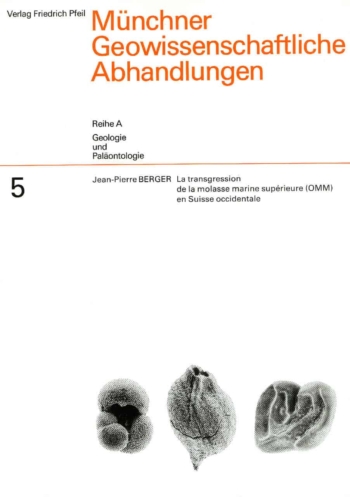
La Transgression de la Molasse Marine superieure (OMM) en Suisse occidentale
45,00 €zzgl. Versandkosten / Versandkostenfrei in D
-
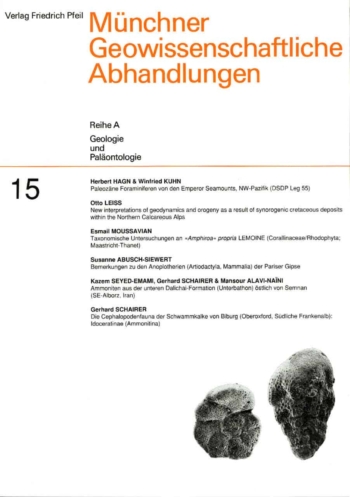
Paleozäne Foraminiferen von den Emperor Seamounts, NW-Pazifik (DSDP Leg 55)
40,00 €zzgl. Versandkosten / Versandkostenfrei in D
Wir sind gerne für Sie da
Verlag Dr. Friedrich Pfeil
Wolfratshauser Str. 27
81379 Munich – Germany
Tel.: +49 89 55 28 6000
Fax: +49 89 55 28 6004
E-Mail: info@pfeil-verlag.de
